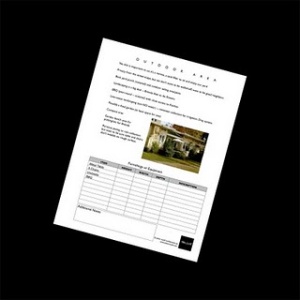
See, I got the title down to one word. In our plan, we have this room right off the living room. It’s one of those multi-use use rooms that help save money, space and consumption. Our three bedroom house won’t have the third bedroom sitting vacant all the time.
The Lawrence Street House – Plumbing
 One way to save energy is through a compact plumbing design. One of our goals as we laid out the design was to keep the plumbing — especially the hot water runs — as short as possible.
One way to save energy is through a compact plumbing design. One of our goals as we laid out the design was to keep the plumbing — especially the hot water runs — as short as possible.
The Lawrence Street House – Schematic Pt 2
 As we started the design, we looked at our relationships of rooms to each other (from our notebook), the aspects of the rooms we wanted (the den needed to also double as a guest bedroom) and the relationships of all of this to the outdoor living areas of our lot and our relationship to the neighborhood.
As we started the design, we looked at our relationships of rooms to each other (from our notebook), the aspects of the rooms we wanted (the den needed to also double as a guest bedroom) and the relationships of all of this to the outdoor living areas of our lot and our relationship to the neighborhood.
The Lawrence Street House – Site Analysis
 I know this wasn’t a one word title; sorry. Before we start designing (and the excitement of getting started builds, so there’s still that temptation. Resist!), we take a really good look at the site. We call this our site analysis. Yeah, not very creative, but accurate.
I know this wasn’t a one word title; sorry. Before we start designing (and the excitement of getting started builds, so there’s still that temptation. Resist!), we take a really good look at the site. We call this our site analysis. Yeah, not very creative, but accurate.
The Lawrence Street House – Schematic Pt 1
 We’ve started the design. After we synthesize the notebook (it’s good to organize your thoughts, even when designing your own home), we started sketching. I plotted out a scale site plan with the surrounding houses, trees, streets, etc.
We’ve started the design. After we synthesize the notebook (it’s good to organize your thoughts, even when designing your own home), we started sketching. I plotted out a scale site plan with the surrounding houses, trees, streets, etc.
The Lawrence Street House – Programming


The Lawrence Street House – Site
 I know this picture is probably a bit hard for you to read and see. But that isn’t really the most relevant part of this post. As my wife and I were looking for a lot to build on, there were some factors that affected our decision.
I know this picture is probably a bit hard for you to read and see. But that isn’t really the most relevant part of this post. As my wife and I were looking for a lot to build on, there were some factors that affected our decision.
The Lawrence Street House – Beginnings
 I know it’s been a while since my last blog, so I’ll bring those of you who are new to thesimpleHOUSE up to date. Our kids are grown. We raised them in a 2,750 sq ft house that worked really well as they passed through their teen years and into adulthood. But now our daughter is married (they had their second anniversary in August) and our son just graduated from college and will be moving out soon. So we’re very close to being two people in what is now seeming to be a very large house. So last summer, after much searching, we found a wonderful urban infill lot in downtown Eugene, Oregon (our home town). We have the 2,750 sq ft house on the market for sale (let me know if you’re interested; it’s nice and doesn’t quite qualify as a McMansion) and are starting the design process. We recently did a LEED Platinum house (theSAGE in previous posts) that pulled out all the stops on sustainability. And you know, it wasn’t really that hard to do. So armed with a desire to be in something around 1,600 square feet, within walking distance of most amenities and that “itch” that I, as an architect, get about every decade, we’re designing another home. Stay tuned.
I know it’s been a while since my last blog, so I’ll bring those of you who are new to thesimpleHOUSE up to date. Our kids are grown. We raised them in a 2,750 sq ft house that worked really well as they passed through their teen years and into adulthood. But now our daughter is married (they had their second anniversary in August) and our son just graduated from college and will be moving out soon. So we’re very close to being two people in what is now seeming to be a very large house. So last summer, after much searching, we found a wonderful urban infill lot in downtown Eugene, Oregon (our home town). We have the 2,750 sq ft house on the market for sale (let me know if you’re interested; it’s nice and doesn’t quite qualify as a McMansion) and are starting the design process. We recently did a LEED Platinum house (theSAGE in previous posts) that pulled out all the stops on sustainability. And you know, it wasn’t really that hard to do. So armed with a desire to be in something around 1,600 square feet, within walking distance of most amenities and that “itch” that I, as an architect, get about every decade, we’re designing another home. Stay tuned.



